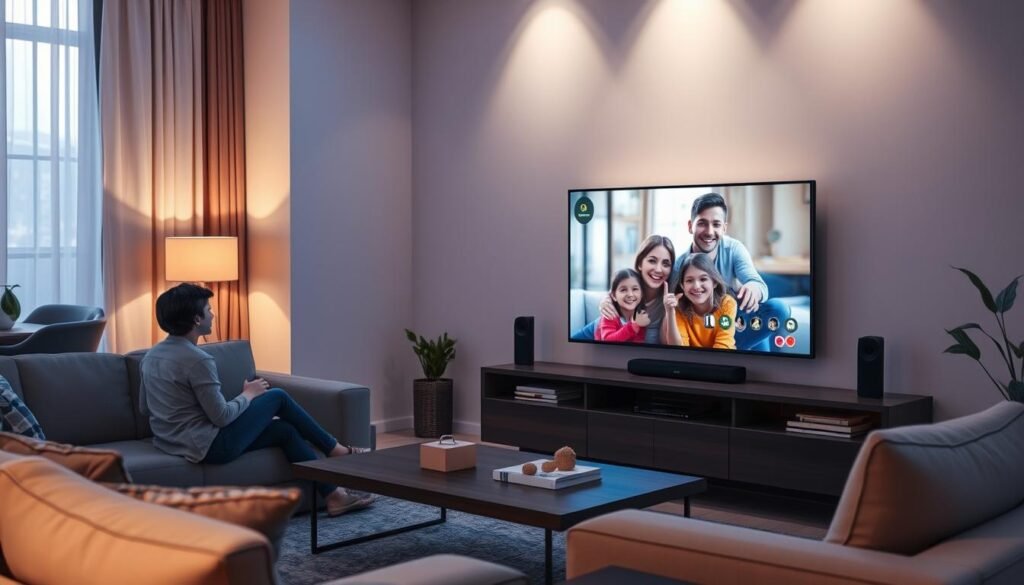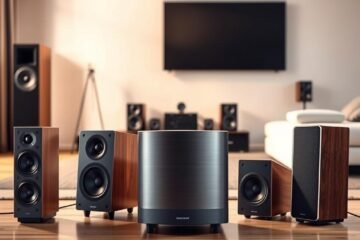Are you ready to turn your home into a voice-controlled paradise? Smart speakers are key in modern home tech. But, with so many choices, how do you find the Best Smart Speakrs for your home in 2025 ?
In 2025, smart home tech has grown a lot. Now, you can find voice assistants and smart speakers for everything. They can control your music and even your thermostat. Whether you’re new to virtual assistants or upgrading, picking the right smart speaker is key for easy home control.
Prices range from the Amazon Echo Dot at $28 to the Sonos Era 100 at $249. There’s a smart speaker for every budget and need. Look for features like voice control, sound quality, and multi-room options. Think about what you need to find the perfect match which may be considered as the Best Smart Speakers for your home in 2025.
Key Takeaways
- Smart speakers range from $28 to $379, catering to various budgets
- Voice assistants like Alexa, Google Assistant, and Siri offer different capabilities
- Consider room size, intended usage, and integration needs when choosing
- Sound quality varies significantly between models
- Privacy features are crucial in today’s connected homes
- Some brands offer extended warranties and flexible payment options
Understanding Smart Speaker Basics and Technology
Smart speakers have changed how we control our homes, making it easier with voice commands. They bring together many features in one device. This makes them a key part of today’s homes. Let’s look at the main parts of smart speaker tech.
Voice Assistant Platforms Overview
The smart speaker world is led by Amazon Alexa, Google Assistant, and Apple’s Siri. Each has its own special features and works with different smart devices. Alexa has the most compatible products, while Apple HomeKit focuses on security.
| Voice Assistant | Ecosystem | Notable Feature |
|---|---|---|
| Alexa | Amazon | Widest product compatibility |
| Google Assistant | Google Home | Advanced AI capabilities |
| Siri | Apple HomeKit | Enhanced security |
Key Smart Speaker Components
Smart speakers have important parts. They have good microphones for hearing you, strong speakers for sound, and processors for handling commands. Some also have touchscreens for more control.
Wireless Connectivity Options
Wireless tech is key for linking smart devices. Most use Wi-Fi, on 2.4 GHz or 5 GHz. The new Wi-Fi 6E works on 6 GHz for faster speeds. Bluetooth is also common for streaming music. Some devices use smart hubs for better connection in your home.
“Smart speakers combine various smart features in one hub for easy access, making them a cornerstone of modern smart homes.”
Popular Smart Speaker Brands in 2025
In 2025, the smart speaker market is filled with innovative brands. Amazon Echo, Google Nest, and Apple HomePod lead the way. Each brand offers unique features that appeal to different users.
Amazon Echo is a top choice with its wide range of products. The Echo Show 15 has a big screen, perfect for family use and fun. The Echo Dot, priced between $30 to $40, is a great value for those who want something small.
Google Nest has made a big impact with the Nest Hub Max. It controls your smart home and lets you video call. The Nest Audio, priced at $90, is great for music lovers.
Apple’s HomePod mini is popular among iOS users. It fits well with Apple’s ecosystem. The full-sized HomePod offers top-notch sound for those who care about audio quality.
Sonos and Bose have found their places in the market. Sonos is known for its ability to play music across rooms. Bose is famous for its sound engineering.
| Brand | Popular Model | Price Range | Key Feature |
|---|---|---|---|
| Amazon | Echo Show 15 | $200-$250 | Large display, family organization |
| Nest Hub Max | $180-$230 | Video calling, smart home control | |
| Apple | HomePod mini | $90-$110 | iOS integration, compact design |
| Sonos | One SL | $150-$200 | Multi-room audio |
| Bose | Home Speaker 500 | $300-$350 | Premium sound quality |
The Matter protocol has made it easier to use different smart speakers together. This means you can mix and match devices from various brands in your home.
How to Choose the best Smart Speaker for Your Home in 2025
Choosing the right smart speaker for your home is important. With 74.2 million users in the US, they’re a big part of our lives. Let’s look at what to consider when picking one.
Room Size Considerations
The size of your room matters when picking a speaker. Big rooms might need a strong speaker like the Sonos Move. It’s 24 x 16 x 12.6cm. Smaller rooms might do well with something like the Sonos One, which is 16.1 x 11.7 x 12cm.
Budget Planning
Speakers vary in price. You can find them for as low as $50 or as high as over $300. The Google Nest Hub (2nd Gen) is a good deal at $99.99. But, the JBL Authentics 300 costs $349.95 for better features.
Intended Usage Assessment
Think about how you’ll use the speaker. If it’s for music, look at the sound quality. For controlling your home, check if it works with your devices. Your voice assistant preference also matters.
Integration Requirements
It’s key that the speaker fits with your smart home. Make sure it works with your devices and voice assistant. The Google Nest Hub has a 7-inch screen and Bluetooth 5.0, making it great for many setups.
| Speaker Model | Price Range | Key Features |
|---|---|---|
| Sonos One | $199 – $419 | Compact size, great sound quality |
| Sonos Move | $318 – $579 | Portable, weatherproof |
| JBL Authentics 300 | $349.95 – $349.99 | Premium audio, retro design |
| Google Nest Hub (2nd Gen) | $99.99 – $109.99 | Touch screen, sleep sensing |
Sound Quality and Audio Performance Features
When picking a smart speaker, sound quality is key. The newest models have amazing sound tech that changes how you listen. Let’s look at what makes a smart speaker sound great.
Speaker Size and Power Output
The size and power of a speaker affect its sound. Big speakers like the Sonos Era 300 fill rooms with sound and deep bass. For smaller spaces, the Amazon Echo Dot (5th Gen) packs a punch in a tiny body.
| Speaker Model | Size (cm) | Power Output | Price |
|---|---|---|---|
| Sonos Era 300 | 18.25 x 12 x 13.05 | Not specified | Premium |
| Amazon Echo Dot (5th Gen) | 10 x 10 x 8.9 | 44mm front-firing | $49.99 |
| Google Nest Audio | Not specified | 0.75″ tweeter, 3″ woofer | $99.99 |
Audio Technology and Processing
Advanced audio tech makes sound clearer and deeper. Many top speakers support spatial audio and Dolby Atmos for an immersive feel. The Apple HomePod mini, despite being small, has a full-range driver and passive radiator for deep sound.
Multi-Room Audio Capabilities
Multi-room audio is a big plus for filling your home with sound. Speakers like the Sonos One (Gen 2) are great for playing the same music in every room. They support Wi-Fi and AirPlay 2 for easy system growth.
“The Sonos Era 100 offers exceptional audio quality with features like TruePlay tuning and adjustable EQ, making it a top choice for audiophiles.”
Choosing the right speaker means finding the right balance of size, power, and tech. Think about connectivity and voice assistant features to find the perfect smart speaker for your home.
Smart Home Integration Capabilities
Smart speakers are key in today’s homes, controlling many devices. Look for speakers that work with Matter, Zigbee, and Thread. These protocols help devices talk to each other smoothly, making your home smart.
The Matter protocol is becoming more popular in 2025. It makes it easier for devices to work together. For example, the Amazon Echo (4th Generation) supports Matter. This means you can control many devices with just your voice.
Zigbee and Thread are also important. They offer strong, low-power connections for devices. The Google Nest Learning Thermostat, for instance, works well with these protocols. It lets you control it with a smart speaker, saving energy and money.
- Philips Hue Smart Bulbs: Adjust lighting using voice commands
- August Wi-Fi Smart Lock: Lock and unlock doors remotely
- Nest Doorbell (Battery): View visitors and receive alerts
- TP-Link Tapo Smart Plug: Control appliances and monitor energy usage
When picking a smart speaker, think about what devices it can work with. Some, like Echo models, have built-in hubs. Others integrate with many devices through software. A smart speaker with great integration makes your home more connected and efficient.
After you pick a speaker, consider audio glasses to keep voice control with you anywhere.
Voice Assistant Features and Performance
Smart speakers have changed how we control our homes with voice commands. The quality of these AI helpers can greatly affect your smart home experience. Let’s explore what makes a voice assistant good.
Command Recognition Accuracy
Top smart speakers are great at hearing your voice, even when it’s loud. The Amazon Echo (4th Gen) is a standout, with a 4.5 Outstanding rating for voice recognition. It answers your voice commands fast, making it a top pick for your home.
Response Speed and Reliability
Fast and reliable responses are key for smooth interactions. The Google Nest Audio is known for its quick and dependable answers. Its voice recognition is top-notch, so you won’t have to repeat yourself.

Language Support Options
For families who speak different languages, having many language options is important. Alexa and Google Assistant lead in this area, offering many languages. This lets everyone use the device in their own language, improving the experience for all.
| Voice Assistant | Command Accuracy | Response Speed | Language Support |
|---|---|---|---|
| Amazon Alexa | Excellent | Fast | Extensive |
| Google Assistant | Very Good | Very Fast | Extensive |
| Apple Siri | Good | Moderate | Limited |
When picking a smart speaker, think about these AI features. You want a device that understands you well, responds quickly, and supports your language. The right voice assistant can make your smart home life easier and more fun.
Privacy and Security Considerations
Smart speakers are now common in many homes, with over 66 million Americans owning one. It’s important to know about the privacy and security they offer. Let’s look at features that keep your data safe and your mind at ease.
Data Protection Features
Data encryption is key for smart speaker security. It keeps your voice commands and personal info private. Choose devices with strong encryption to protect your data, both on the device and when it’s sent.
Microphone Controls
Privacy controls are crucial for smart speaker use. Most devices have mute buttons to turn off the microphone. This adds privacy when you need it most.
Security Updates and Support
Regular software updates are vital for keeping your smart speaker safe. Manufacturers support their devices for 4-5 years. These updates fix bugs and improve security, protecting against new threats.
| Brand | Support Duration | Update Frequency |
|---|---|---|
| Amazon | 4-5 years | Monthly |
| 4-5 years | Quarterly | |
| Apple | 5 years | Bi-monthly |
By focusing on these security features, you can enjoy smart speakers while keeping your privacy. Always check and delete recorded commands. Also, use two-factor authentication for extra security in your smart home.
Setup and User Experience
Setting up your smart speaker in 2025 is easy thanks to simple interfaces and mobile apps. Most devices need a smartphone app for setup, making it fast and easy. You can also customize voice control to fit your needs, improving your experience.
Voice profiles have changed the game, offering personalized responses for everyone in your home. This feature ensures each person gets a unique experience with the smart speaker. Some models, like the Echo Show series, even have touchscreens for better control.
Wireless connectivity has made smart speakers even more popular. Many 2025 models use Wi-Fi and Bluetooth, making them easy to place anywhere without cords.
| Feature | Benefit |
|---|---|
| Mobile app integration | Easy setup and management |
| Voice control customization | Personalized user experience |
| Touchscreen interfaces | Enhanced interaction options |
| Voice profiles | Tailored responses for multiple users |
Smart speakers have become a key part of many homes. Their adoption rate keeps growing, with more homes adding devices like Amazon Echo and Google Home. These devices are great for controlling your home, playing music, or finding information, thanks to their easy-to-use nature.
Price Range and Value Analysis
Smart speakers come in many prices, fitting different budgets and needs. In 2025, we see everything from affordable options to high-end models. These offer top-notch audio experiences.
Entry-Level Options
For those new to smart homes, budget smart speakers are ideal. The Amazon Echo Dot costs $22.99 and is a great deal. Google’s Nest Home Mini, at $49, is also affordable. These small devices have basic smart features and good sound for their size.
Mid-Range Selections
Looking for better sound? Check out the fourth-generation Amazon Echo ($54.99) and Google Nest Audio ($75). They offer richer sound and more features, making them a good middle ground.
Premium Speaker Features
For the best sound, consider the Amazon Echo Studio ($199.99) or Apple HomePod 2 ($299). These speakers have top sound quality, advanced smart home features, and the latest tech. They’re more expensive but perfect for those who love great sound.
| Price Range | Examples | Key Features |
|---|---|---|
| Budget ($20-$50) | Echo Dot, Google Nest Mini | Basic functionality, compact size |
| Mid-range ($50-$100) | Amazon Echo, Google Nest Audio | Improved sound, more features |
| Premium ($200+) | Echo Studio, Apple HomePod 2 | High-end audio, advanced integration |
When picking a smart speaker, think about your budget and what you need. Budget models are perfect for simple needs. Premium speakers offer the best sound. Mid-range options are a good middle ground, offering value and quality.
Additional Features and Special Functions
Smart speakers have evolved a lot. They now offer more than just voice control. Let’s look at some cool features that can make your smart home better.

Smart displays are changing the game. They show you information and let you video call. For example, the Amazon Echo Hub is a great smart home controller because of its display.
Intercom functionality is also a big plus. It lets you talk between rooms, turning your speakers into a home intercom. This is great for big homes or families with kids.
Customizable routines are key in smart homes. They let you do many things with just one command. You can make a “Good Morning” routine that turns on lights, reads the news, and starts your coffee maker all at once.
Some smart speakers have special sensors. The latest HomePod, for example, has sensors for temperature and humidity. These can start other smart home actions, like changing the thermostat or turning on a dehumidifier.
- The Echo Dot with Clock has an LED display for quick time checks
- Ecobee Smart Thermostat Premium offers full Alexa support and better remote sensors
- Google’s Pixel Tablet works as a smart display when docked
When picking a smart speaker, think about these extra features. They can really improve your smart home life, making it more convenient and connected.
Conclusion
Choosing the best smart speaker for your home in 2025 is important. Smart home tech is now in 53.9% of US homes, showing its growing role. Think about sound quality, smart home integration, and voice assistant features that fit your needs.
When comparing smart speakers, Google Home and Amazon Echo are leaders, with Echo at 67% in the US. Google Assistant works with over 50,000 smart home devices from more than 10,000 brands. This makes it a great choice for easy integration. Also, pick a device that will work with new tech like Matter for the future.
Your budget is key in choosing a smart speaker. The smart home market is expected to be worth USD 100.42 billion in 2023. You can find options at different prices. Look for a balance between features and cost. By considering these points and getting advice tailored to you, you’ll find a smart speaker that improves your home life for years.
Related: Audio Glasses
Explore our Best Audio Glasses (Fall 2025) for open-ear music, clearer calls, and smart-assistant control.







[…] Ready to upgrade your home? Let’s look at the devices that will shape the future of connected homes. […]
[…] to: How to choose the best smart speaker for your home in 2025 for complete […]